CPCCBC4007A Assessment 3: Site Establishment Plan & Org Chart Analysis
VerifiedAdded on 2023/06/15
|15
|2637
|189
Report
AI Summary
This document presents a solution to CPCCBC4007A Assessment 3, focusing on the creation of a site establishment plan and an organizational chart. The site establishment plan details security measures, access points, signage, environmental considerations, site accommodation for up to 30 people, and service locations, emphasizing the importance of a pre-entry survey and precautionary measures. The organizational chart outlines the structure of a small to medium-sized construction company, illustrating the relationships between different personnel, including the construction manager, supervisors, site managers, estimators, and other staff, while also discussing factors influencing organizational structure such as environment, strategy, technology, and human resources. Additionally, the report touches on the roles of contractors and subcontractors, the significance of contracts, and the application of the critical path method for project completion, providing insights into project planning and management.

CPCCBC4007A: Assessment 3
Student’s Name:
Institutional Affiliation:
Course name and Number:
Instructor’s Name:
Student’s Name:
Institutional Affiliation:
Course name and Number:
Instructor’s Name:
Paraphrase This Document
Need a fresh take? Get an instant paraphrase of this document with our AI Paraphraser
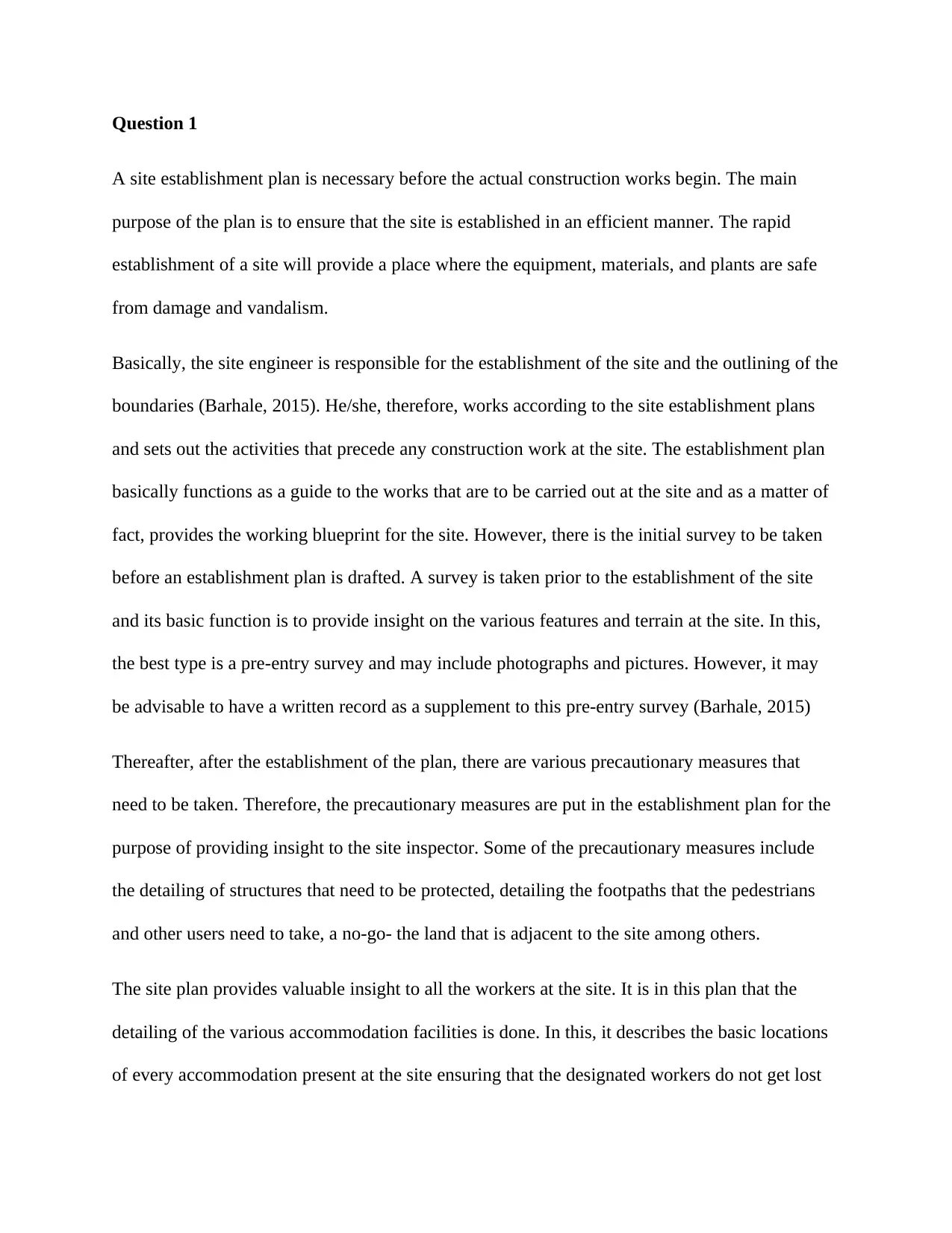
Question 1
A site establishment plan is necessary before the actual construction works begin. The main
purpose of the plan is to ensure that the site is established in an efficient manner. The rapid
establishment of a site will provide a place where the equipment, materials, and plants are safe
from damage and vandalism.
Basically, the site engineer is responsible for the establishment of the site and the outlining of the
boundaries (Barhale, 2015). He/she, therefore, works according to the site establishment plans
and sets out the activities that precede any construction work at the site. The establishment plan
basically functions as a guide to the works that are to be carried out at the site and as a matter of
fact, provides the working blueprint for the site. However, there is the initial survey to be taken
before an establishment plan is drafted. A survey is taken prior to the establishment of the site
and its basic function is to provide insight on the various features and terrain at the site. In this,
the best type is a pre-entry survey and may include photographs and pictures. However, it may
be advisable to have a written record as a supplement to this pre-entry survey (Barhale, 2015)
Thereafter, after the establishment of the plan, there are various precautionary measures that
need to be taken. Therefore, the precautionary measures are put in the establishment plan for the
purpose of providing insight to the site inspector. Some of the precautionary measures include
the detailing of structures that need to be protected, detailing the footpaths that the pedestrians
and other users need to take, a no-go- the land that is adjacent to the site among others.
The site plan provides valuable insight to all the workers at the site. It is in this plan that the
detailing of the various accommodation facilities is done. In this, it describes the basic locations
of every accommodation present at the site ensuring that the designated workers do not get lost
A site establishment plan is necessary before the actual construction works begin. The main
purpose of the plan is to ensure that the site is established in an efficient manner. The rapid
establishment of a site will provide a place where the equipment, materials, and plants are safe
from damage and vandalism.
Basically, the site engineer is responsible for the establishment of the site and the outlining of the
boundaries (Barhale, 2015). He/she, therefore, works according to the site establishment plans
and sets out the activities that precede any construction work at the site. The establishment plan
basically functions as a guide to the works that are to be carried out at the site and as a matter of
fact, provides the working blueprint for the site. However, there is the initial survey to be taken
before an establishment plan is drafted. A survey is taken prior to the establishment of the site
and its basic function is to provide insight on the various features and terrain at the site. In this,
the best type is a pre-entry survey and may include photographs and pictures. However, it may
be advisable to have a written record as a supplement to this pre-entry survey (Barhale, 2015)
Thereafter, after the establishment of the plan, there are various precautionary measures that
need to be taken. Therefore, the precautionary measures are put in the establishment plan for the
purpose of providing insight to the site inspector. Some of the precautionary measures include
the detailing of structures that need to be protected, detailing the footpaths that the pedestrians
and other users need to take, a no-go- the land that is adjacent to the site among others.
The site plan provides valuable insight to all the workers at the site. It is in this plan that the
detailing of the various accommodation facilities is done. In this, it describes the basic locations
of every accommodation present at the site ensuring that the designated workers do not get lost
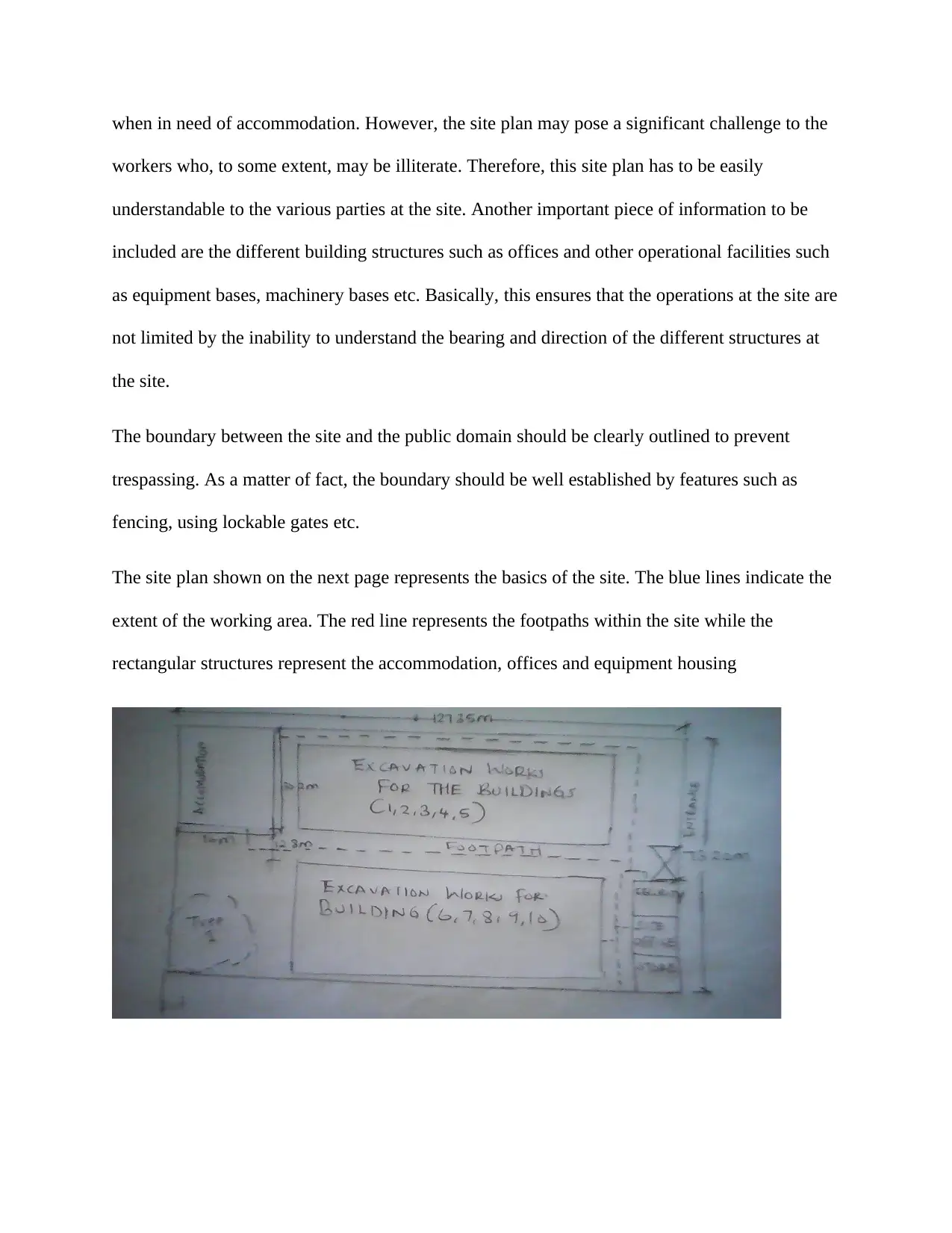
when in need of accommodation. However, the site plan may pose a significant challenge to the
workers who, to some extent, may be illiterate. Therefore, this site plan has to be easily
understandable to the various parties at the site. Another important piece of information to be
included are the different building structures such as offices and other operational facilities such
as equipment bases, machinery bases etc. Basically, this ensures that the operations at the site are
not limited by the inability to understand the bearing and direction of the different structures at
the site.
The boundary between the site and the public domain should be clearly outlined to prevent
trespassing. As a matter of fact, the boundary should be well established by features such as
fencing, using lockable gates etc.
The site plan shown on the next page represents the basics of the site. The blue lines indicate the
extent of the working area. The red line represents the footpaths within the site while the
rectangular structures represent the accommodation, offices and equipment housing
workers who, to some extent, may be illiterate. Therefore, this site plan has to be easily
understandable to the various parties at the site. Another important piece of information to be
included are the different building structures such as offices and other operational facilities such
as equipment bases, machinery bases etc. Basically, this ensures that the operations at the site are
not limited by the inability to understand the bearing and direction of the different structures at
the site.
The boundary between the site and the public domain should be clearly outlined to prevent
trespassing. As a matter of fact, the boundary should be well established by features such as
fencing, using lockable gates etc.
The site plan shown on the next page represents the basics of the site. The blue lines indicate the
extent of the working area. The red line represents the footpaths within the site while the
rectangular structures represent the accommodation, offices and equipment housing
⊘ This is a preview!⊘
Do you want full access?
Subscribe today to unlock all pages.

Trusted by 1+ million students worldwide
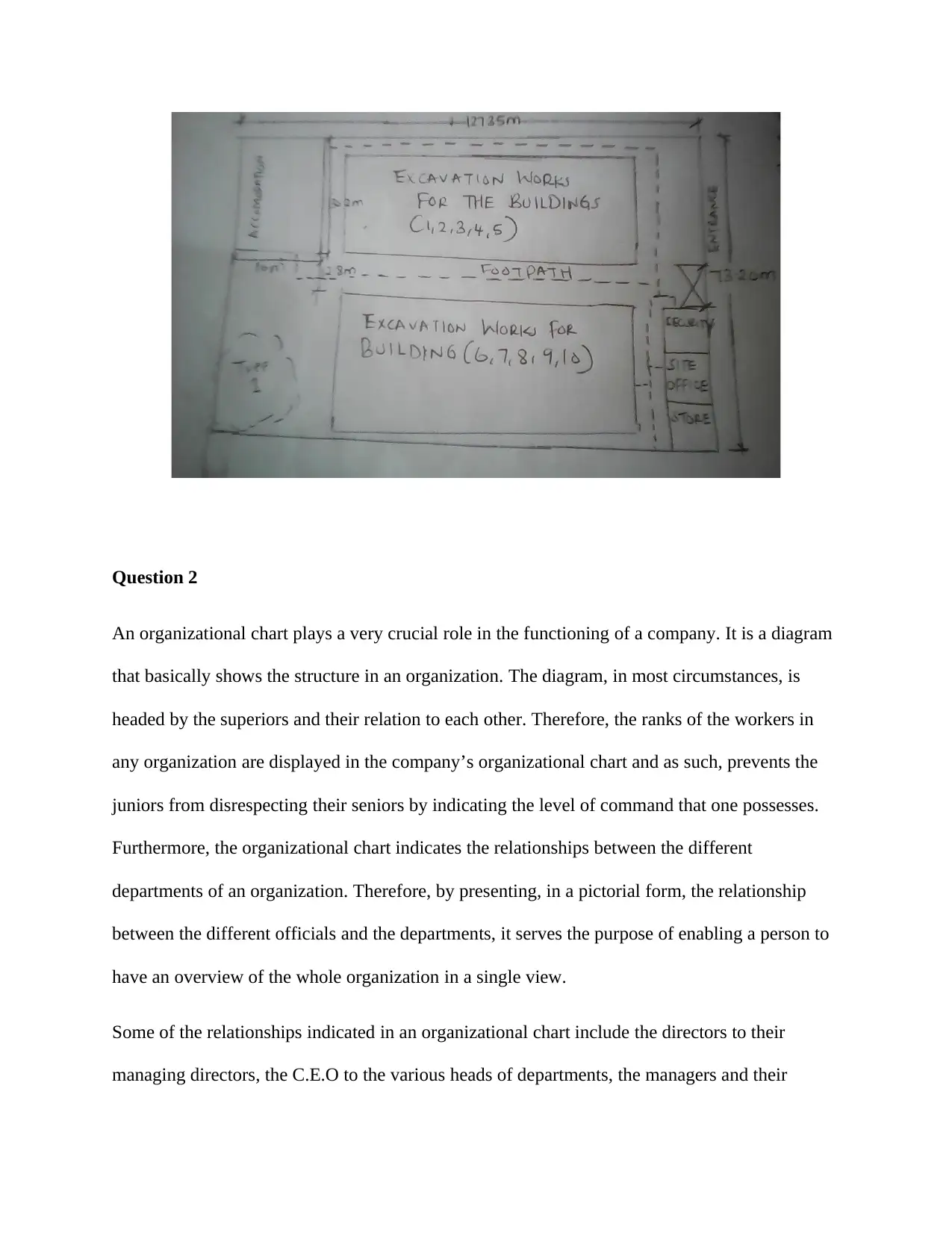
Question 2
An organizational chart plays a very crucial role in the functioning of a company. It is a diagram
that basically shows the structure in an organization. The diagram, in most circumstances, is
headed by the superiors and their relation to each other. Therefore, the ranks of the workers in
any organization are displayed in the company’s organizational chart and as such, prevents the
juniors from disrespecting their seniors by indicating the level of command that one possesses.
Furthermore, the organizational chart indicates the relationships between the different
departments of an organization. Therefore, by presenting, in a pictorial form, the relationship
between the different officials and the departments, it serves the purpose of enabling a person to
have an overview of the whole organization in a single view.
Some of the relationships indicated in an organizational chart include the directors to their
managing directors, the C.E.O to the various heads of departments, the managers and their
An organizational chart plays a very crucial role in the functioning of a company. It is a diagram
that basically shows the structure in an organization. The diagram, in most circumstances, is
headed by the superiors and their relation to each other. Therefore, the ranks of the workers in
any organization are displayed in the company’s organizational chart and as such, prevents the
juniors from disrespecting their seniors by indicating the level of command that one possesses.
Furthermore, the organizational chart indicates the relationships between the different
departments of an organization. Therefore, by presenting, in a pictorial form, the relationship
between the different officials and the departments, it serves the purpose of enabling a person to
have an overview of the whole organization in a single view.
Some of the relationships indicated in an organizational chart include the directors to their
managing directors, the C.E.O to the various heads of departments, the managers and their
Paraphrase This Document
Need a fresh take? Get an instant paraphrase of this document with our AI Paraphraser
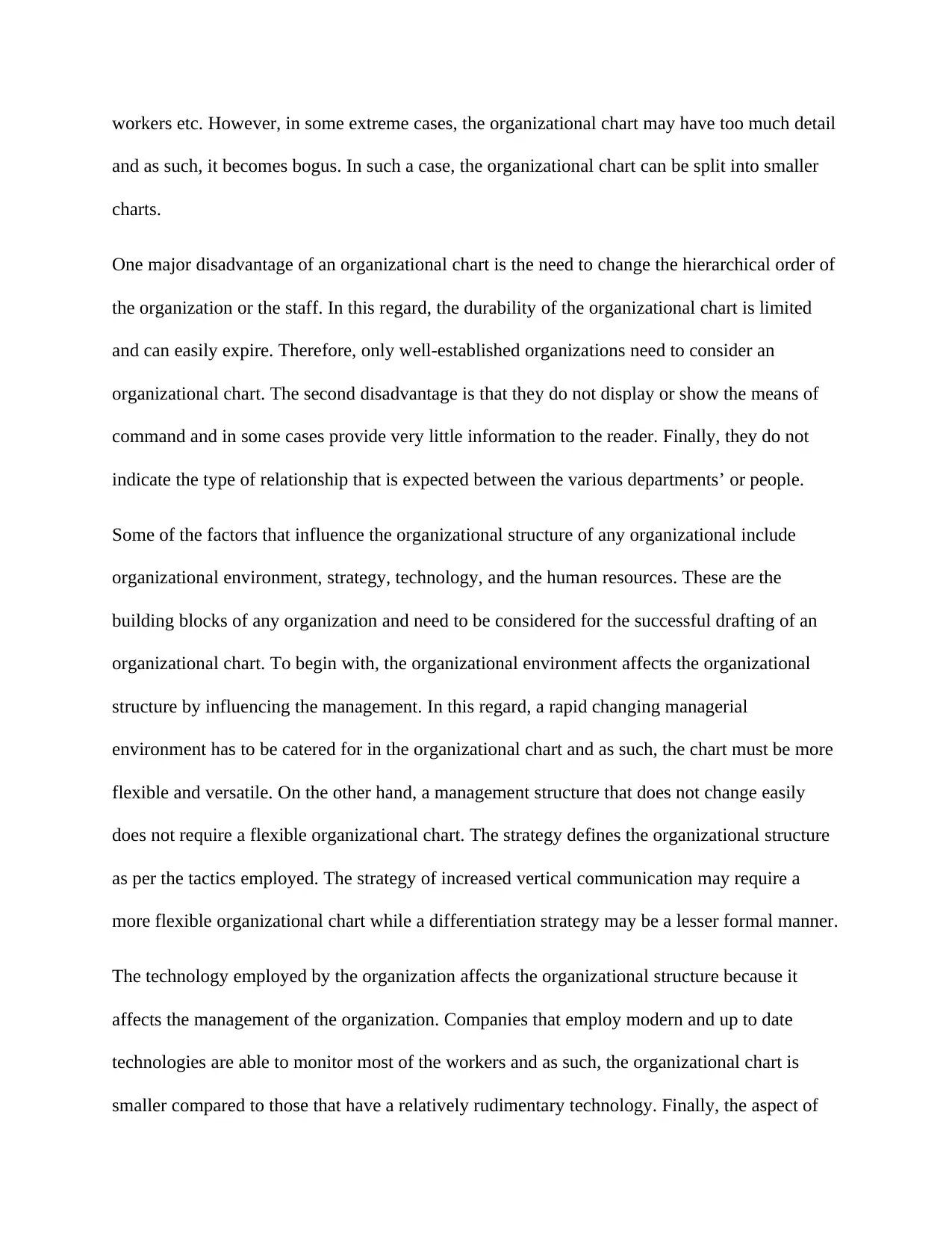
workers etc. However, in some extreme cases, the organizational chart may have too much detail
and as such, it becomes bogus. In such a case, the organizational chart can be split into smaller
charts.
One major disadvantage of an organizational chart is the need to change the hierarchical order of
the organization or the staff. In this regard, the durability of the organizational chart is limited
and can easily expire. Therefore, only well-established organizations need to consider an
organizational chart. The second disadvantage is that they do not display or show the means of
command and in some cases provide very little information to the reader. Finally, they do not
indicate the type of relationship that is expected between the various departments’ or people.
Some of the factors that influence the organizational structure of any organizational include
organizational environment, strategy, technology, and the human resources. These are the
building blocks of any organization and need to be considered for the successful drafting of an
organizational chart. To begin with, the organizational environment affects the organizational
structure by influencing the management. In this regard, a rapid changing managerial
environment has to be catered for in the organizational chart and as such, the chart must be more
flexible and versatile. On the other hand, a management structure that does not change easily
does not require a flexible organizational chart. The strategy defines the organizational structure
as per the tactics employed. The strategy of increased vertical communication may require a
more flexible organizational chart while a differentiation strategy may be a lesser formal manner.
The technology employed by the organization affects the organizational structure because it
affects the management of the organization. Companies that employ modern and up to date
technologies are able to monitor most of the workers and as such, the organizational chart is
smaller compared to those that have a relatively rudimentary technology. Finally, the aspect of
and as such, it becomes bogus. In such a case, the organizational chart can be split into smaller
charts.
One major disadvantage of an organizational chart is the need to change the hierarchical order of
the organization or the staff. In this regard, the durability of the organizational chart is limited
and can easily expire. Therefore, only well-established organizations need to consider an
organizational chart. The second disadvantage is that they do not display or show the means of
command and in some cases provide very little information to the reader. Finally, they do not
indicate the type of relationship that is expected between the various departments’ or people.
Some of the factors that influence the organizational structure of any organizational include
organizational environment, strategy, technology, and the human resources. These are the
building blocks of any organization and need to be considered for the successful drafting of an
organizational chart. To begin with, the organizational environment affects the organizational
structure by influencing the management. In this regard, a rapid changing managerial
environment has to be catered for in the organizational chart and as such, the chart must be more
flexible and versatile. On the other hand, a management structure that does not change easily
does not require a flexible organizational chart. The strategy defines the organizational structure
as per the tactics employed. The strategy of increased vertical communication may require a
more flexible organizational chart while a differentiation strategy may be a lesser formal manner.
The technology employed by the organization affects the organizational structure because it
affects the management of the organization. Companies that employ modern and up to date
technologies are able to monitor most of the workers and as such, the organizational chart is
smaller compared to those that have a relatively rudimentary technology. Finally, the aspect of
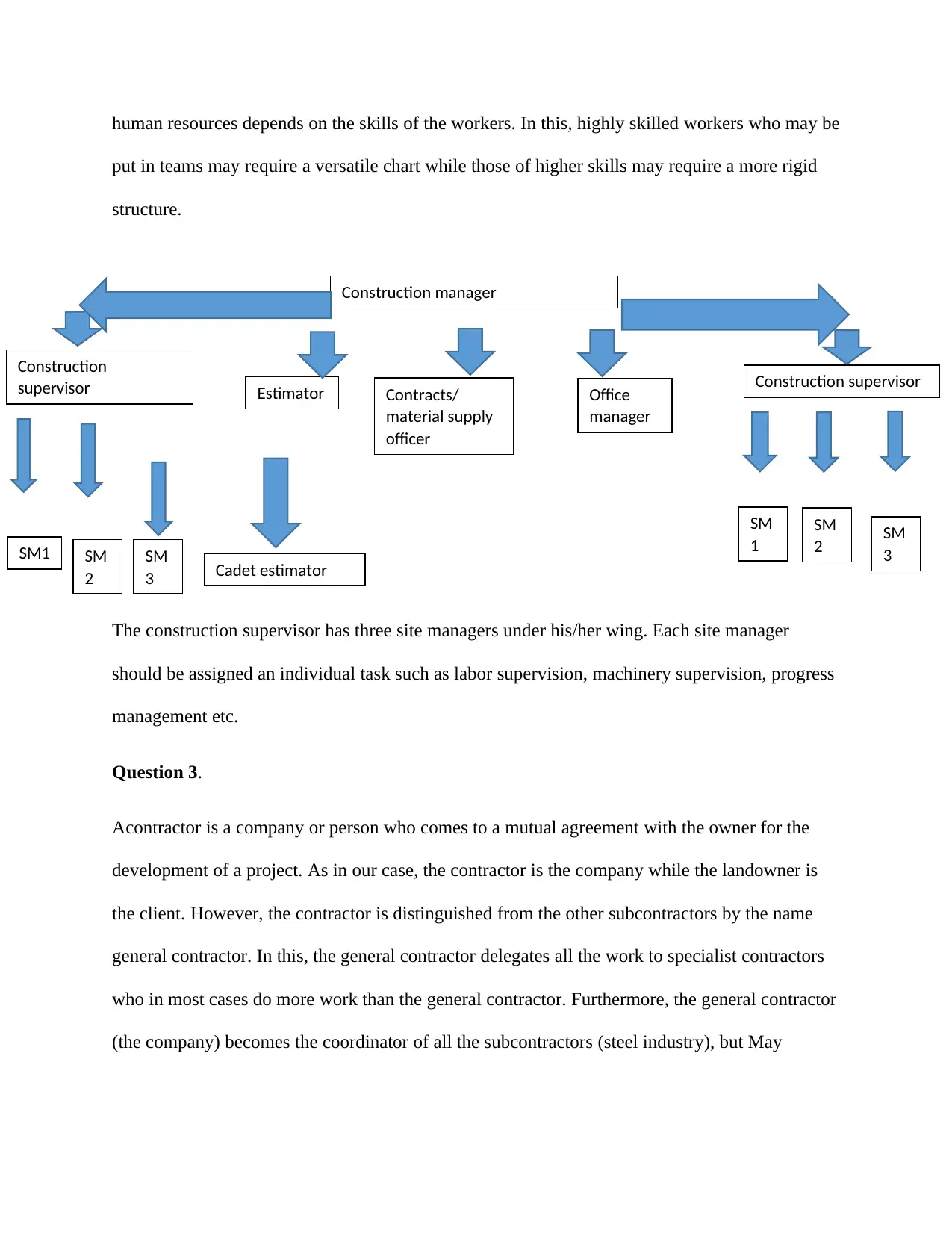
human resources depends on the skills of the workers. In this, highly skilled workers who may be
put in teams may require a versatile chart while those of higher skills may require a more rigid
structure.
The construction supervisor has three site managers under his/her wing. Each site manager
should be assigned an individual task such as labor supervision, machinery supervision, progress
management etc.
Question 3.
Acontractor is a company or person who comes to a mutual agreement with the owner for the
development of a project. As in our case, the contractor is the company while the landowner is
the client. However, the contractor is distinguished from the other subcontractors by the name
general contractor. In this, the general contractor delegates all the work to specialist contractors
who in most cases do more work than the general contractor. Furthermore, the general contractor
(the company) becomes the coordinator of all the subcontractors (steel industry), but May
Construction
supervisor Construction supervisor
SM1
SM
1
Estimator
Cadet estimator
Office
manager
Contracts/
material supply
officer
Construction manager
SM
2
SM
3
SM
2 SM
3
put in teams may require a versatile chart while those of higher skills may require a more rigid
structure.
The construction supervisor has three site managers under his/her wing. Each site manager
should be assigned an individual task such as labor supervision, machinery supervision, progress
management etc.
Question 3.
Acontractor is a company or person who comes to a mutual agreement with the owner for the
development of a project. As in our case, the contractor is the company while the landowner is
the client. However, the contractor is distinguished from the other subcontractors by the name
general contractor. In this, the general contractor delegates all the work to specialist contractors
who in most cases do more work than the general contractor. Furthermore, the general contractor
(the company) becomes the coordinator of all the subcontractors (steel industry), but May
Construction
supervisor Construction supervisor
SM1
SM
1
Estimator
Cadet estimator
Office
manager
Contracts/
material supply
officer
Construction manager
SM
2
SM
3
SM
2 SM
3
⊘ This is a preview!⊘
Do you want full access?
Subscribe today to unlock all pages.

Trusted by 1+ million students worldwide
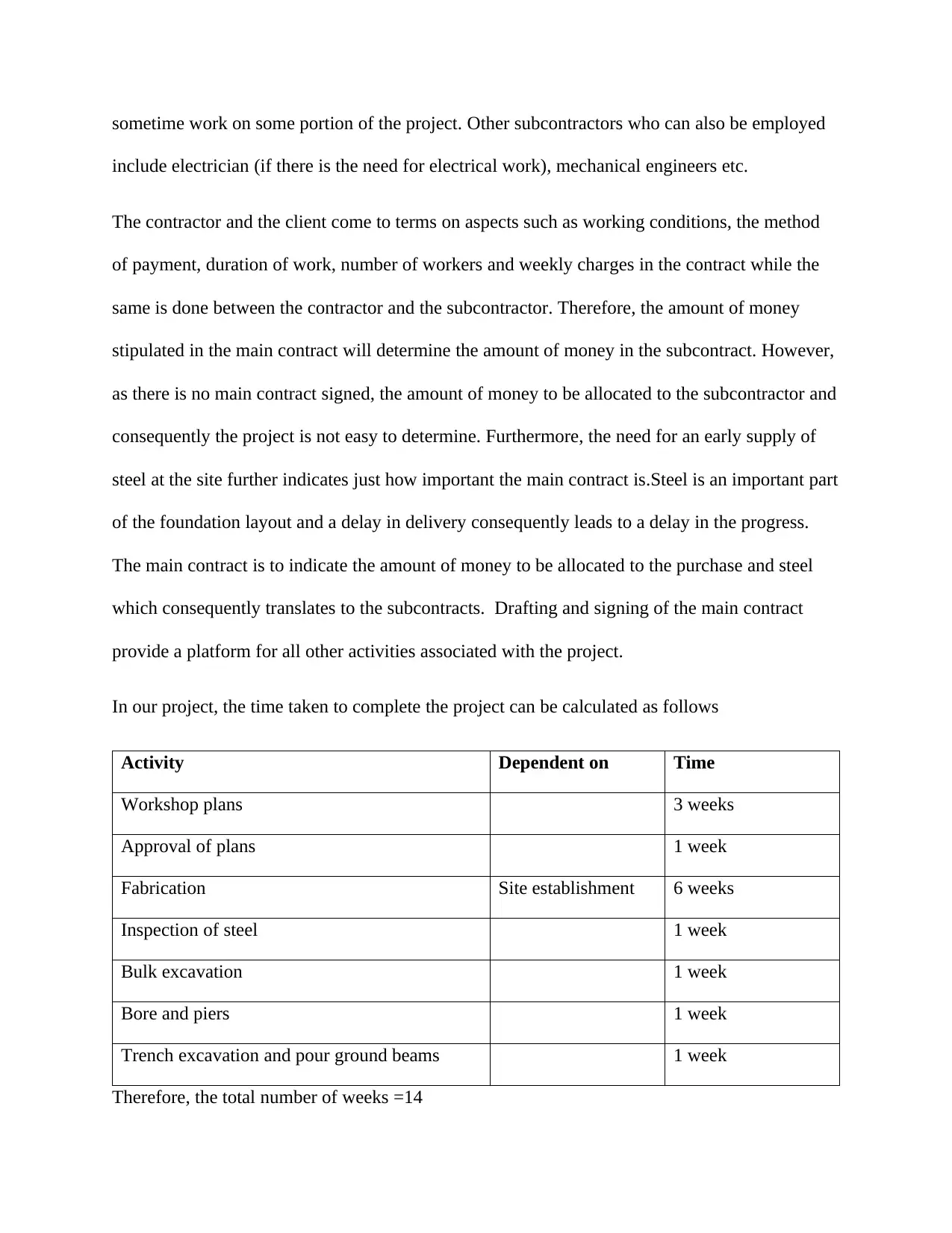
sometime work on some portion of the project. Other subcontractors who can also be employed
include electrician (if there is the need for electrical work), mechanical engineers etc.
The contractor and the client come to terms on aspects such as working conditions, the method
of payment, duration of work, number of workers and weekly charges in the contract while the
same is done between the contractor and the subcontractor. Therefore, the amount of money
stipulated in the main contract will determine the amount of money in the subcontract. However,
as there is no main contract signed, the amount of money to be allocated to the subcontractor and
consequently the project is not easy to determine. Furthermore, the need for an early supply of
steel at the site further indicates just how important the main contract is.Steel is an important part
of the foundation layout and a delay in delivery consequently leads to a delay in the progress.
The main contract is to indicate the amount of money to be allocated to the purchase and steel
which consequently translates to the subcontracts. Drafting and signing of the main contract
provide a platform for all other activities associated with the project.
In our project, the time taken to complete the project can be calculated as follows
Activity Dependent on Time
Workshop plans 3 weeks
Approval of plans 1 week
Fabrication Site establishment 6 weeks
Inspection of steel 1 week
Bulk excavation 1 week
Bore and piers 1 week
Trench excavation and pour ground beams 1 week
Therefore, the total number of weeks =14
include electrician (if there is the need for electrical work), mechanical engineers etc.
The contractor and the client come to terms on aspects such as working conditions, the method
of payment, duration of work, number of workers and weekly charges in the contract while the
same is done between the contractor and the subcontractor. Therefore, the amount of money
stipulated in the main contract will determine the amount of money in the subcontract. However,
as there is no main contract signed, the amount of money to be allocated to the subcontractor and
consequently the project is not easy to determine. Furthermore, the need for an early supply of
steel at the site further indicates just how important the main contract is.Steel is an important part
of the foundation layout and a delay in delivery consequently leads to a delay in the progress.
The main contract is to indicate the amount of money to be allocated to the purchase and steel
which consequently translates to the subcontracts. Drafting and signing of the main contract
provide a platform for all other activities associated with the project.
In our project, the time taken to complete the project can be calculated as follows
Activity Dependent on Time
Workshop plans 3 weeks
Approval of plans 1 week
Fabrication Site establishment 6 weeks
Inspection of steel 1 week
Bulk excavation 1 week
Bore and piers 1 week
Trench excavation and pour ground beams 1 week
Therefore, the total number of weeks =14
Paraphrase This Document
Need a fresh take? Get an instant paraphrase of this document with our AI Paraphraser
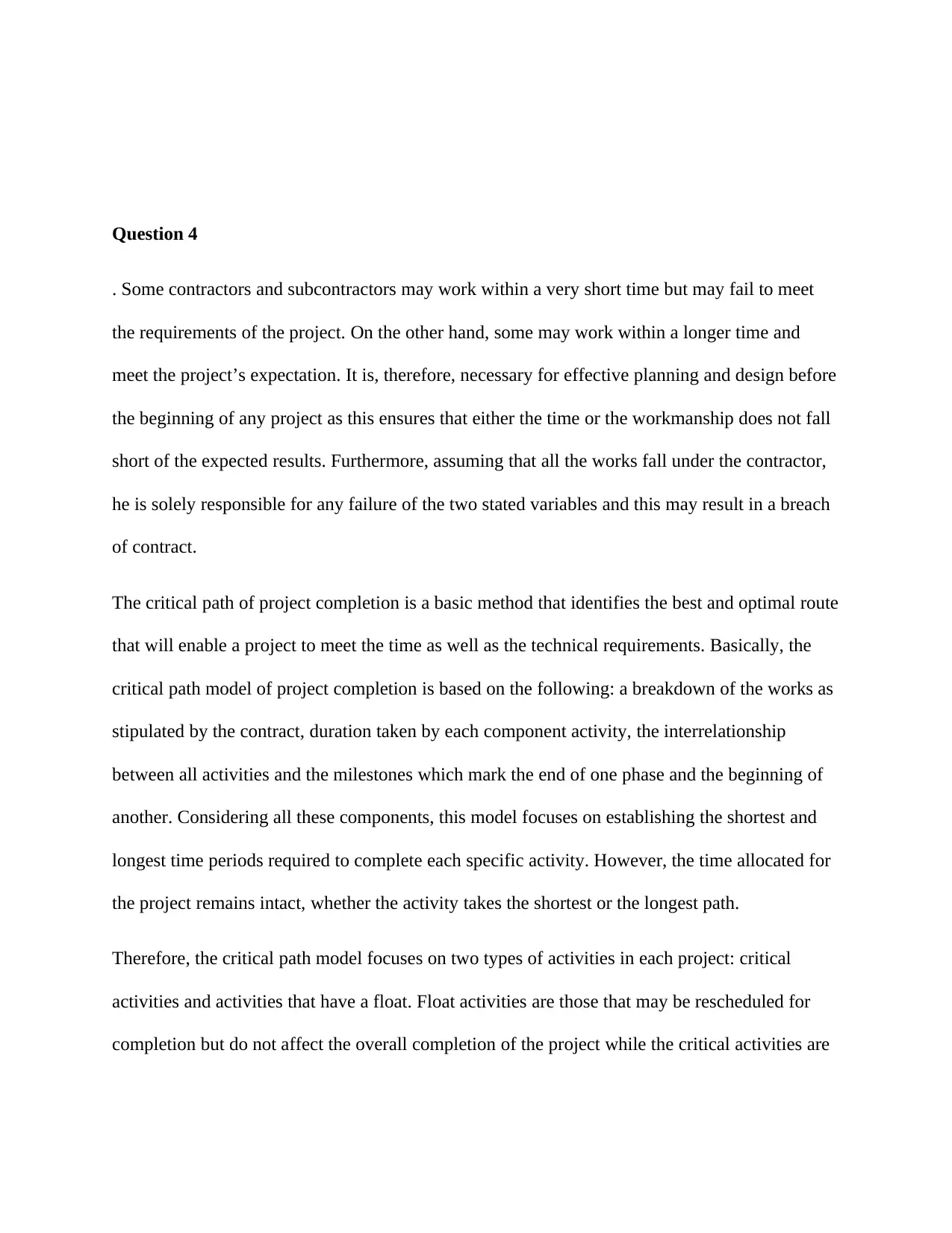
Question 4
. Some contractors and subcontractors may work within a very short time but may fail to meet
the requirements of the project. On the other hand, some may work within a longer time and
meet the project’s expectation. It is, therefore, necessary for effective planning and design before
the beginning of any project as this ensures that either the time or the workmanship does not fall
short of the expected results. Furthermore, assuming that all the works fall under the contractor,
he is solely responsible for any failure of the two stated variables and this may result in a breach
of contract.
The critical path of project completion is a basic method that identifies the best and optimal route
that will enable a project to meet the time as well as the technical requirements. Basically, the
critical path model of project completion is based on the following: a breakdown of the works as
stipulated by the contract, duration taken by each component activity, the interrelationship
between all activities and the milestones which mark the end of one phase and the beginning of
another. Considering all these components, this model focuses on establishing the shortest and
longest time periods required to complete each specific activity. However, the time allocated for
the project remains intact, whether the activity takes the shortest or the longest path.
Therefore, the critical path model focuses on two types of activities in each project: critical
activities and activities that have a float. Float activities are those that may be rescheduled for
completion but do not affect the overall completion of the project while the critical activities are
. Some contractors and subcontractors may work within a very short time but may fail to meet
the requirements of the project. On the other hand, some may work within a longer time and
meet the project’s expectation. It is, therefore, necessary for effective planning and design before
the beginning of any project as this ensures that either the time or the workmanship does not fall
short of the expected results. Furthermore, assuming that all the works fall under the contractor,
he is solely responsible for any failure of the two stated variables and this may result in a breach
of contract.
The critical path of project completion is a basic method that identifies the best and optimal route
that will enable a project to meet the time as well as the technical requirements. Basically, the
critical path model of project completion is based on the following: a breakdown of the works as
stipulated by the contract, duration taken by each component activity, the interrelationship
between all activities and the milestones which mark the end of one phase and the beginning of
another. Considering all these components, this model focuses on establishing the shortest and
longest time periods required to complete each specific activity. However, the time allocated for
the project remains intact, whether the activity takes the shortest or the longest path.
Therefore, the critical path model focuses on two types of activities in each project: critical
activities and activities that have a float. Float activities are those that may be rescheduled for
completion but do not affect the overall completion of the project while the critical activities are
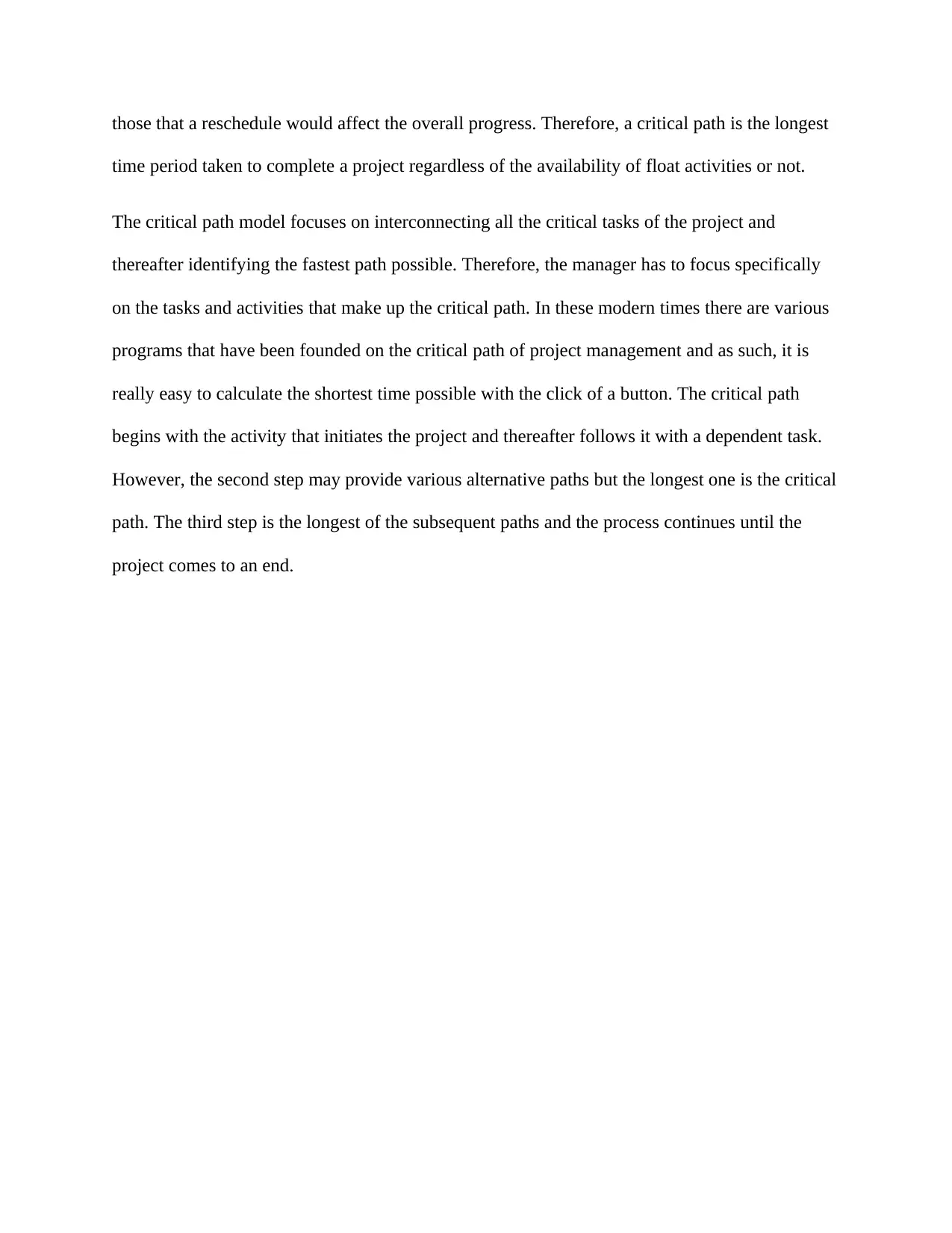
those that a reschedule would affect the overall progress. Therefore, a critical path is the longest
time period taken to complete a project regardless of the availability of float activities or not.
The critical path model focuses on interconnecting all the critical tasks of the project and
thereafter identifying the fastest path possible. Therefore, the manager has to focus specifically
on the tasks and activities that make up the critical path. In these modern times there are various
programs that have been founded on the critical path of project management and as such, it is
really easy to calculate the shortest time possible with the click of a button. The critical path
begins with the activity that initiates the project and thereafter follows it with a dependent task.
However, the second step may provide various alternative paths but the longest one is the critical
path. The third step is the longest of the subsequent paths and the process continues until the
project comes to an end.
time period taken to complete a project regardless of the availability of float activities or not.
The critical path model focuses on interconnecting all the critical tasks of the project and
thereafter identifying the fastest path possible. Therefore, the manager has to focus specifically
on the tasks and activities that make up the critical path. In these modern times there are various
programs that have been founded on the critical path of project management and as such, it is
really easy to calculate the shortest time possible with the click of a button. The critical path
begins with the activity that initiates the project and thereafter follows it with a dependent task.
However, the second step may provide various alternative paths but the longest one is the critical
path. The third step is the longest of the subsequent paths and the process continues until the
project comes to an end.
⊘ This is a preview!⊘
Do you want full access?
Subscribe today to unlock all pages.

Trusted by 1+ million students worldwide
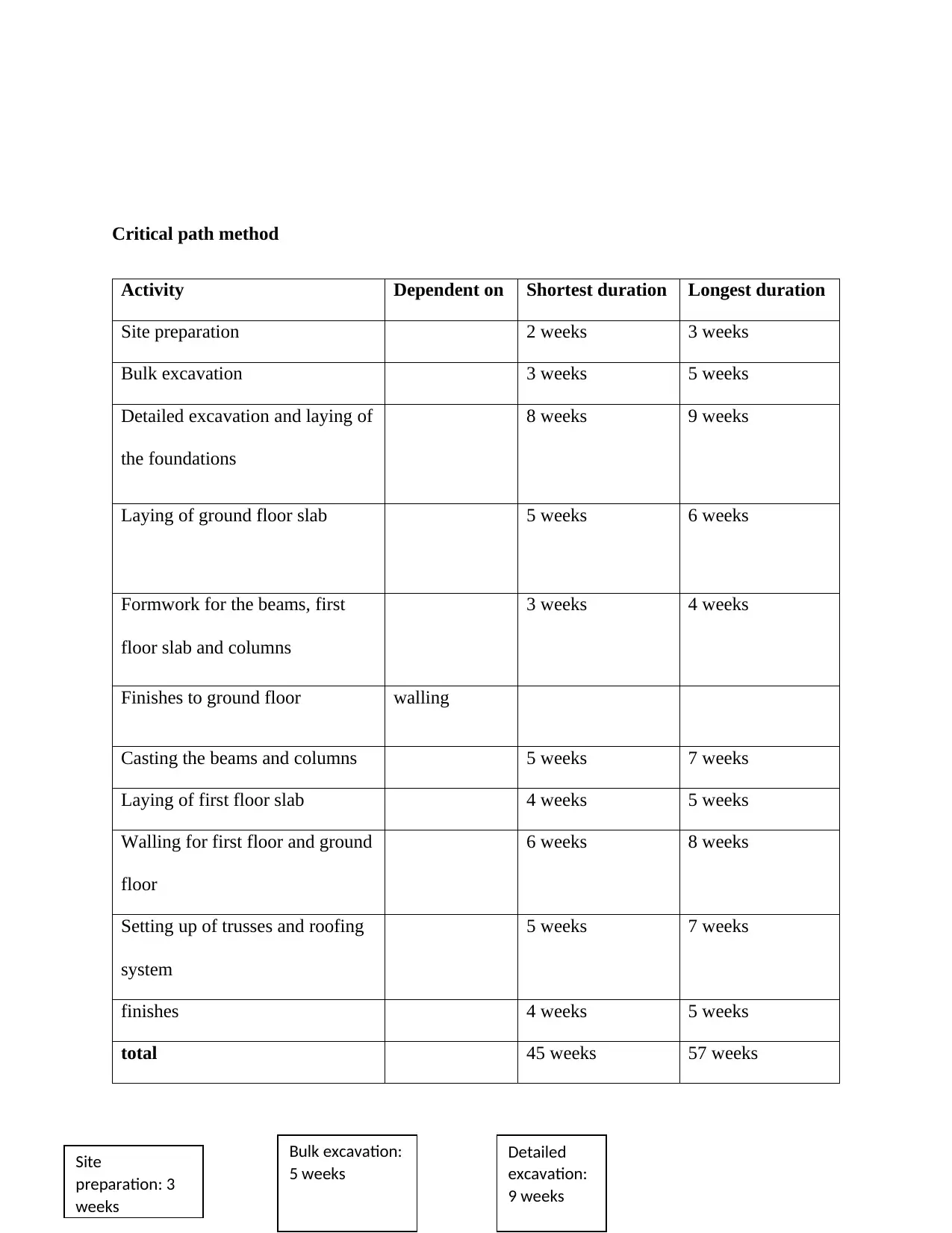
Critical path method
Activity Dependent on Shortest duration Longest duration
Site preparation 2 weeks 3 weeks
Bulk excavation 3 weeks 5 weeks
Detailed excavation and laying of
the foundations
8 weeks 9 weeks
Laying of ground floor slab 5 weeks 6 weeks
Formwork for the beams, first
floor slab and columns
3 weeks 4 weeks
Finishes to ground floor walling
Casting the beams and columns 5 weeks 7 weeks
Laying of first floor slab 4 weeks 5 weeks
Walling for first floor and ground
floor
6 weeks 8 weeks
Setting up of trusses and roofing
system
5 weeks 7 weeks
finishes 4 weeks 5 weeks
total 45 weeks 57 weeks
Site
preparation: 3
weeks
Bulk excavation:
5 weeks
Detailed
excavation:
9 weeks
Activity Dependent on Shortest duration Longest duration
Site preparation 2 weeks 3 weeks
Bulk excavation 3 weeks 5 weeks
Detailed excavation and laying of
the foundations
8 weeks 9 weeks
Laying of ground floor slab 5 weeks 6 weeks
Formwork for the beams, first
floor slab and columns
3 weeks 4 weeks
Finishes to ground floor walling
Casting the beams and columns 5 weeks 7 weeks
Laying of first floor slab 4 weeks 5 weeks
Walling for first floor and ground
floor
6 weeks 8 weeks
Setting up of trusses and roofing
system
5 weeks 7 weeks
finishes 4 weeks 5 weeks
total 45 weeks 57 weeks
Site
preparation: 3
weeks
Bulk excavation:
5 weeks
Detailed
excavation:
9 weeks
Paraphrase This Document
Need a fresh take? Get an instant paraphrase of this document with our AI Paraphraser
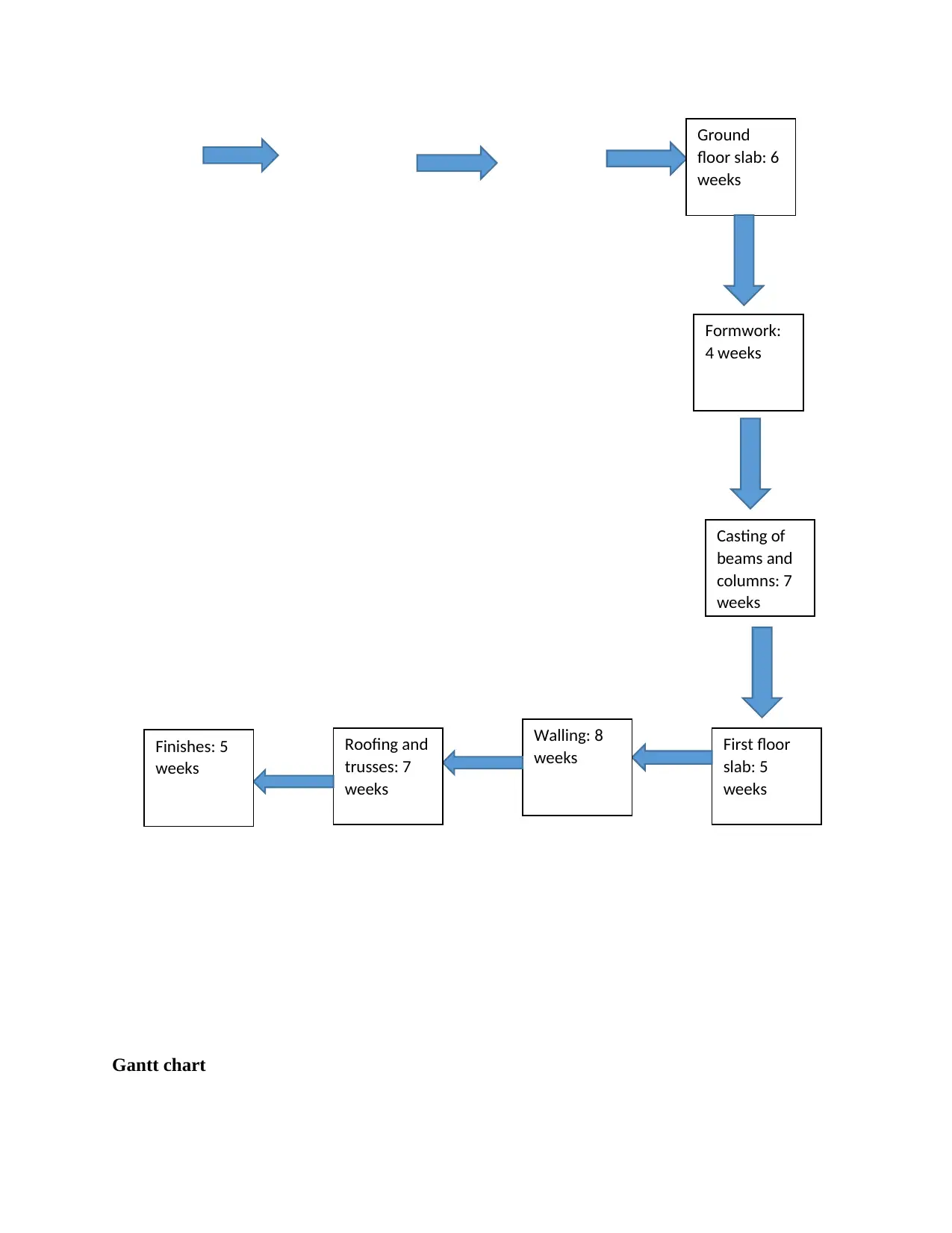
Gantt chart
Ground
floor slab: 6
weeks
Formwork:
4 weeks
Casting of
beams and
columns: 7
weeks
First floor
slab: 5
weeks
Walling: 8
weeks
Roofing and
trusses: 7
weeks
Finishes: 5
weeks
Ground
floor slab: 6
weeks
Formwork:
4 weeks
Casting of
beams and
columns: 7
weeks
First floor
slab: 5
weeks
Walling: 8
weeks
Roofing and
trusses: 7
weeks
Finishes: 5
weeks
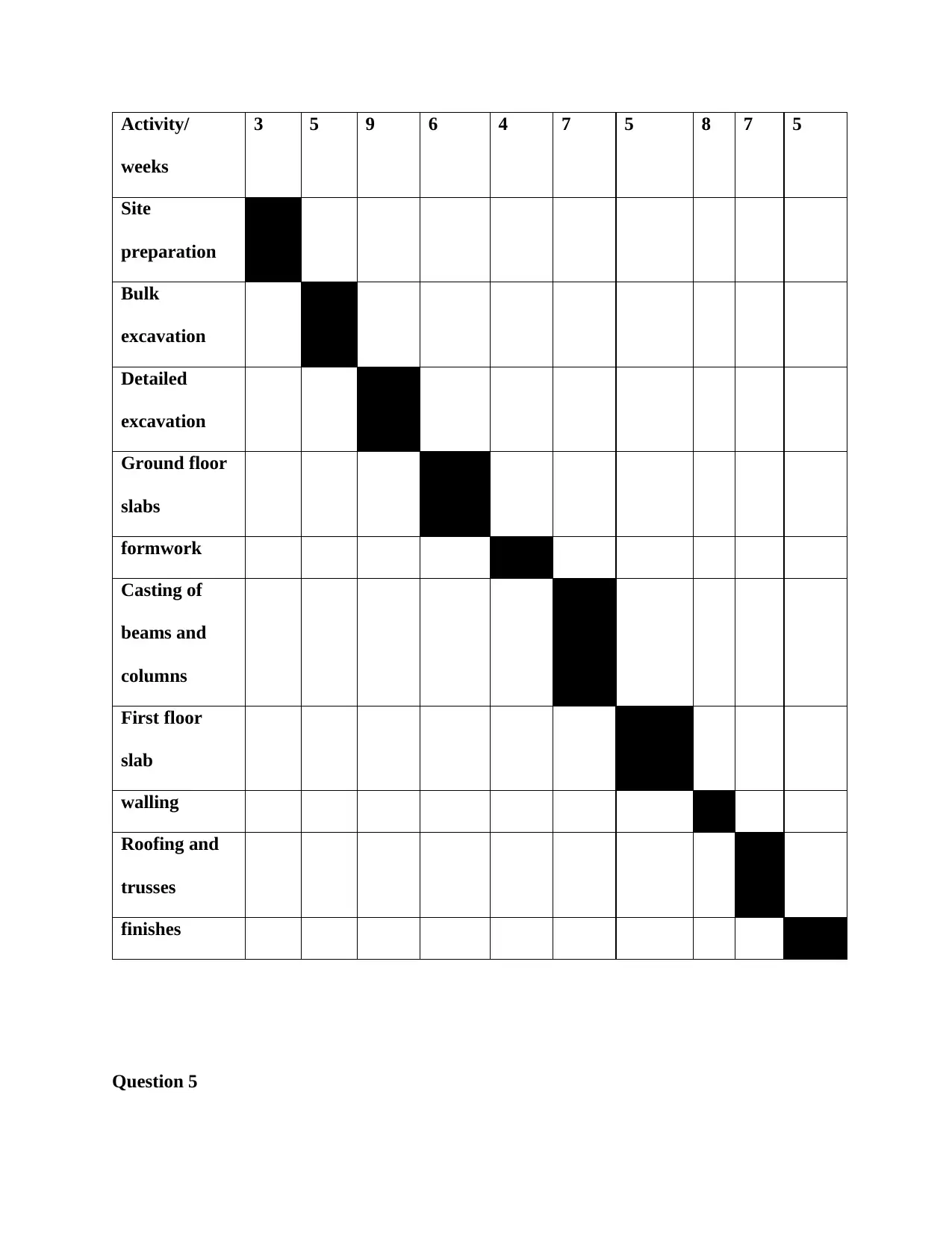
Activity/
weeks
3 5 9 6 4 7 5 8 7 5
Site
preparation
Bulk
excavation
Detailed
excavation
Ground floor
slabs
formwork
Casting of
beams and
columns
First floor
slab
walling
Roofing and
trusses
finishes
Question 5
weeks
3 5 9 6 4 7 5 8 7 5
Site
preparation
Bulk
excavation
Detailed
excavation
Ground floor
slabs
formwork
Casting of
beams and
columns
First floor
slab
walling
Roofing and
trusses
finishes
Question 5
⊘ This is a preview!⊘
Do you want full access?
Subscribe today to unlock all pages.

Trusted by 1+ million students worldwide
1 out of 15
Related Documents
Your All-in-One AI-Powered Toolkit for Academic Success.
+13062052269
info@desklib.com
Available 24*7 on WhatsApp / Email
![[object Object]](/_next/static/media/star-bottom.7253800d.svg)
Unlock your academic potential
Copyright © 2020–2025 A2Z Services. All Rights Reserved. Developed and managed by ZUCOL.





